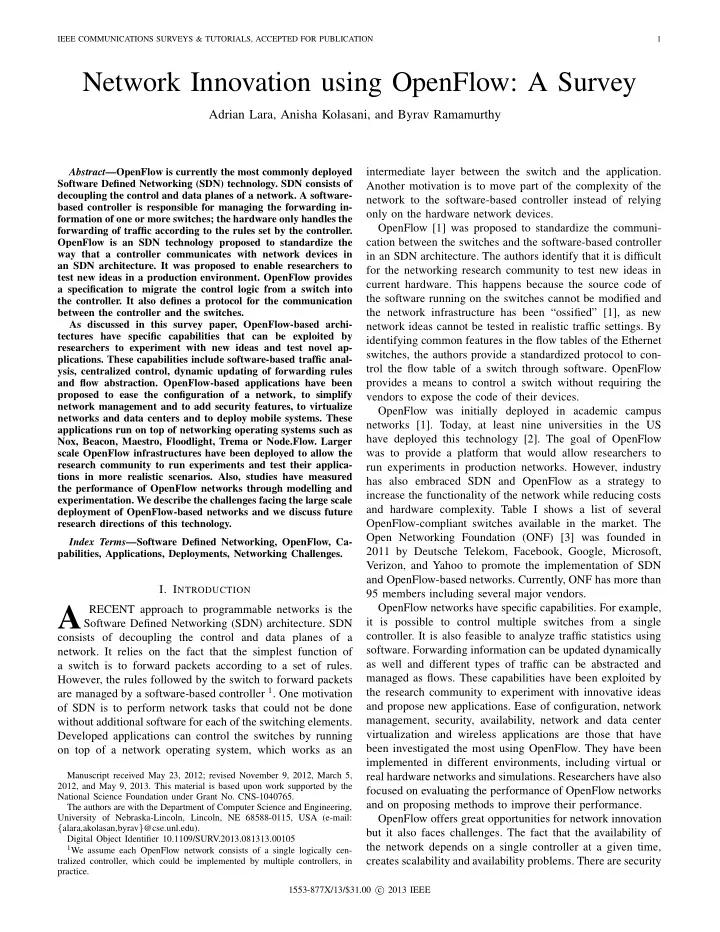

IEEE COMMUNICATIONS SURVEYS & TUTORIALS, ACCEPTED FOR PUBLICATION 1 Network Innovation using OpenFlow: A Survey Adrian Lara, Anisha Kolasani, and Byrav Ramamurthy intermediate layer between the switch and the application. Abstract —OpenFlow is currently the most commonly deployed Software Defined Networking (SDN) technology. SDN consists of Another motivation is to move part of the complexity of the decoupling the control and data planes of a network. A software- network to the software-based controller instead of relying based controller is responsible for managing the forwarding in- only on the hardware network devices. formation of one or more switches; the hardware only handles the OpenFlow [1] was proposed to standardize the communi- forwarding of traffic according to the rules set by the controller. cation between the switches and the software-based controller OpenFlow is an SDN technology proposed to standardize the way that a controller communicates with network devices in in an SDN architecture. The authors identify that it is difficult an SDN architecture. It was proposed to enable researchers to for the networking research community to test new ideas in test new ideas in a production environment. OpenFlow provides current hardware. This happens because the source code of a specification to migrate the control logic from a switch into the software running on the switches cannot be modified and the controller. It also defines a protocol for the communication the network infrastructure has been “ossified” [1], as new between the controller and the switches. As discussed in this survey paper, OpenFlow-based archi- network ideas cannot be tested in realistic traffic settings. By tectures have specific capabilities that can be exploited by identifying common features in the flow tables of the Ethernet researchers to experiment with new ideas and test novel ap- switches, the authors provide a standardized protocol to con- plications. These capabilities include software-based traffic anal- trol the flow table of a switch through software. OpenFlow ysis, centralized control, dynamic updating of forwarding rules provides a means to control a switch without requiring the and flow abstraction. OpenFlow-based applications have been proposed to ease the configuration of a network, to simplify vendors to expose the code of their devices. network management and to add security features, to virtualize OpenFlow was initially deployed in academic campus networks and data centers and to deploy mobile systems. These networks [1]. Today, at least nine universities in the US applications run on top of networking operating systems such as have deployed this technology [2]. The goal of OpenFlow Nox, Beacon, Maestro, Floodlight, Trema or Node.Flow. Larger was to provide a platform that would allow researchers to scale OpenFlow infrastructures have been deployed to allow the research community to run experiments and test their applica- run experiments in production networks. However, industry tions in more realistic scenarios. Also, studies have measured has also embraced SDN and OpenFlow as a strategy to the performance of OpenFlow networks through modelling and increase the functionality of the network while reducing costs experimentation. We describe the challenges facing the large scale and hardware complexity. Table I shows a list of several deployment of OpenFlow-based networks and we discuss future OpenFlow-compliant switches available in the market. The research directions of this technology. Open Networking Foundation (ONF) [3] was founded in Index Terms —Software Defined Networking, OpenFlow, Ca- 2011 by Deutsche Telekom, Facebook, Google, Microsoft, pabilities, Applications, Deployments, Networking Challenges. Verizon, and Yahoo to promote the implementation of SDN and OpenFlow-based networks. Currently, ONF has more than I. I NTRODUCTION 95 members including several major vendors. OpenFlow networks have specific capabilities. For example, RECENT approach to programmable networks is the A it is possible to control multiple switches from a single Software Defined Networking (SDN) architecture. SDN controller. It is also feasible to analyze traffic statistics using consists of decoupling the control and data planes of a software. Forwarding information can be updated dynamically network. It relies on the fact that the simplest function of as well and different types of traffic can be abstracted and a switch is to forward packets according to a set of rules. managed as flows. These capabilities have been exploited by However, the rules followed by the switch to forward packets are managed by a software-based controller 1 . One motivation the research community to experiment with innovative ideas and propose new applications. Ease of configuration, network of SDN is to perform network tasks that could not be done management, security, availability, network and data center without additional software for each of the switching elements. virtualization and wireless applications are those that have Developed applications can control the switches by running been investigated the most using OpenFlow. They have been on top of a network operating system, which works as an implemented in different environments, including virtual or Manuscript received May 23, 2012; revised November 9, 2012, March 5, real hardware networks and simulations. Researchers have also 2012, and May 9, 2013. This material is based upon work supported by the focused on evaluating the performance of OpenFlow networks National Science Foundation under Grant No. CNS-1040765. and on proposing methods to improve their performance. The authors are with the Department of Computer Science and Engineering, University of Nebraska-Lincoln, Lincoln, NE 68588-0115, USA (e-mail: OpenFlow offers great opportunities for network innovation { alara,akolasan,byrav } @cse.unl.edu). but it also faces challenges. The fact that the availability of Digital Object Identifier 10.1109/SURV.2013.081313.00105 the network depends on a single controller at a given time, 1 We assume each OpenFlow network consists of a single logically cen- creates scalability and availability problems. There are security tralized controller, which could be implemented by multiple controllers, in practice. 1553-877X/13/$31.00 c � 2013 IEEE
Recommend
More recommend